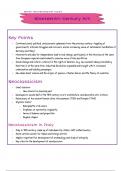Class notes
Class notes ARTH 111 - 19th Century Art
- Course
- ARTH 111
- Institution
- Hunter College - Cuny
Covers 19th century art for Intro to Art History (ARTH 111) Art Covered: - George Washington by Jean-Antoine Houdon - Death of Marat by Jacques-Louis David - Napoleon Crossing the Alps by Jacques-Louis David - A Heroic Feat! With Dead Men! by Francisco de Goya - The Stonebreakers by Gustave C...
[Show more]



